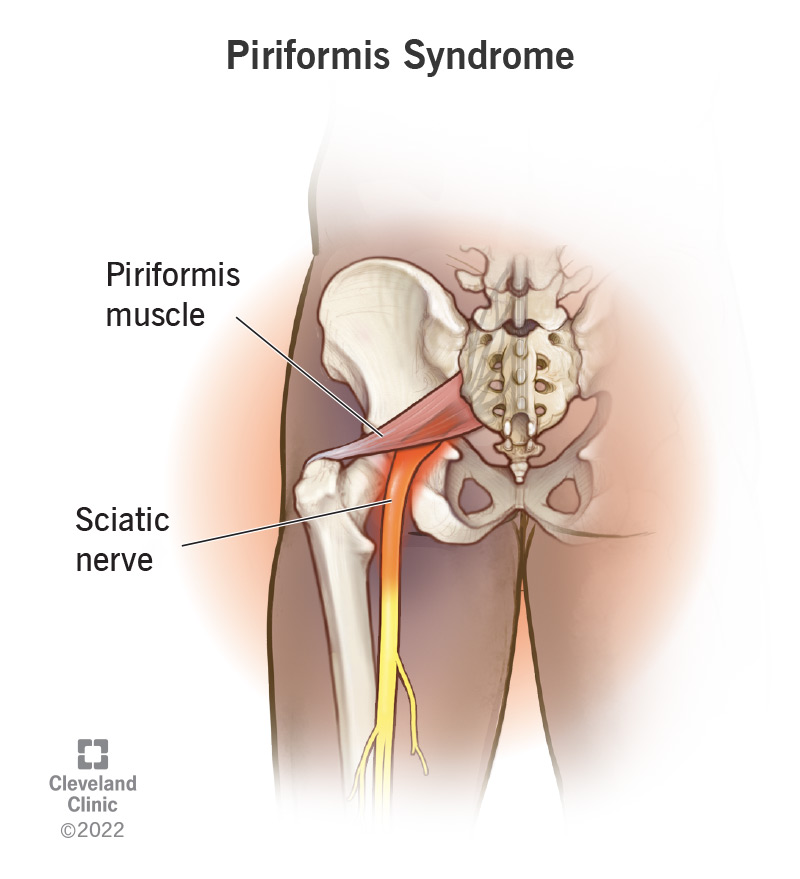Piriformis syndrome causes pain or numbness in your butt, hip or upper leg. It occurs when the piriformis muscle presses on the sciatic nerve. The condition may be caused by injury, swelling, muscle spasms or scar tissue in the piriformis. Most episodes go away in a few days or weeks with rest and simple treatments.
Advertisement
Cleveland Clinic is a non-profit academic medical center. Advertising on our site helps support our mission. We do not endorse non-Cleveland Clinic products or services. Policy
Piriformis syndrome occurs when your piriformis muscle compresses your sciatic nerve and results in inflammation. It can cause pain or numbness in your buttock and down the back of your leg. It can happen on one side of your body or both.
Advertisement
Cleveland Clinic is a non-profit academic medical center. Advertising on our site helps support our mission. We do not endorse non-Cleveland Clinic products or services. Policy
The piriformis is a flat, narrow muscle. It runs from your lower spine through your butt to the top of your thighs. Your piriformis muscle extends to each side of your body and aids in almost every movement of your lower body.
The sciatic nerve most commonly runs underneath the piriformis. The nerve travels from your spinal cord, through your buttocks, down the back of each leg, to your feet. It’s the longest, largest nerve in your body.
Piriformis syndrome is not very common. Scientists believe that piriformis syndrome causes only about 0.3% to 6% of lower back pain.
Although the conditions are sometimes related and both affect the sciatic nerve, they are different.
A herniated disk or spinal stenosis can cause sciatica. The symptoms tend to affect the lower back and can travel down through the buttocks and leg.
Piriformis syndrome only involves the piriformis muscle pressing on one area of the sciatic nerve in the buttock. It can feel a lot like sciatica but in a more specific area.

Anything that makes the piriformis press on the sciatic nerve can cause piriformis syndrome.
The most common piriformis syndrome causes are:
Advertisement
These issues can result from:
But sometimes, abnormal anatomy causes piriformis syndrome. Healthcare providers call this primary piriformis syndrome. For example, a person can be born with a sciatic nerve that takes an abnormal path in their body. Or a person can be born with an unusually formed piriformis muscle or sciatic nerve.
Piriformis syndrome symptoms occur in the butt, hip or upper leg. People often describe the feeling as:
Symptoms may get worse during certain activities, such as:
Diagnosing piriformis syndrome can be difficult and often involves ruling out other causes.
A healthcare provider will:
There are no specific piriformis syndrome tests. But a healthcare provider may order tests to identify other problems that might be causing your symptoms. These tests include:
Piriformis syndrome treatment may include:
Piriformis syndrome surgery is usually not recommended unless all other therapies fail. Surgery for this condition may involve removing scar tissue or other sources of pressure on the nerve.
Piriformis syndrome resolves quickly with lifestyle changes and simple treatments. Symptoms often improve in days or weeks.
But the condition tends to come back, especially in people who don’t follow their healthcare provider’s instructions. Severe cases that aren’t treated properly can greatly reduce a person’s ability to function well.
Advertisement
To prevent piriformis syndrome, including recurrent (repeat) episodes, consider some of the following strategies:
If you have piriformis syndrome, certain adjustments can help you manage the symptoms when they occur:
Advertisement
If you have piriformis syndrome, call your healthcare provider if you experience any of the following:
Piriformis syndrome occurs when the piriformis muscle presses on the sciatic nerve. The condition can cause pain, numbness or tingling in your butt, hip or upper leg. Most episodes go away in a few days or weeks with rest and simple treatments. But talk to your healthcare provider if an injury led to the pain or if symptoms last more than a few weeks.
Advertisement
Cleveland Clinic’s primary care providers offer lifelong medical care. From sinus infections and high blood pressure to preventive screening, we’re here for you.

Last reviewed on 07/13/2022.
Learn more about the Health Library and our editorial process.